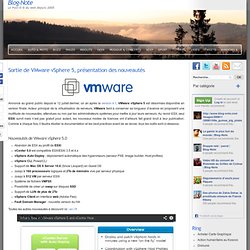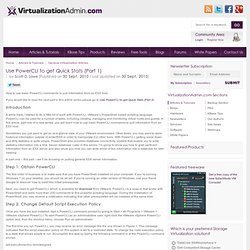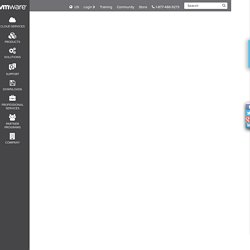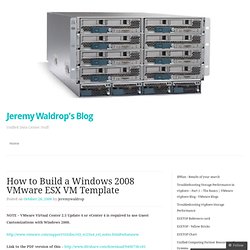

Resolution Paths Published. Location of vCenter Server log files. Timekeeping best practices for Windows, including NTP. Openfiler to Simulate a SAN Storage. Storage For Open Source. Use OpenFiler as your Free VMware ESX SAN Server. By David Davis - January 8, 2009 Many of the VMware ESX Server advanced features cannot be used without a SAN (storage area network).

Besides the high cost of the ESX Server software and the Virtual Infrastructure Suite, a SAN can be a huge barrier to using VMware ESX and features like VMotion, VMware High Availability (VMHA), and VMware Distributed Resource Scheduler (DRS). In this article, we take a look at how you can download a free open-source iSCSI server and use it as your SAN storage for VMware ESX and its advanced features. What is OpenFiler and where do I get it? OpenFiler is a free open-source SAN server. In my case, I downloaded the pre-built VMware virtual disk and used it. I let OpenFiler get an IP address via DHCP and then pointed my web browser to it. How do I configure OpenFiler as an iSCSI Target? Sortie de VMware vSphere 5, présentation des nouveautés. Annoncé au grand public depuis le 12 juillet dernier, un an après la version 4.1, VMware vSphere 5 est désormais disponible en version finale.

Acteur principal de la virtualisation de serveurs, VMware tient à conserver sa longueur d’avance en proposant une multitude de nouveautés, attendues ou non par les administrateurs systèmes pour mettre à jour leurs serveurs. Au revoir ESX, seul ESXi survit mais n’est pas gratuit pour autant, les nouveaux modes de licences ont d’ailleurs fait grand bruit à leur publication. Comme à chaque fois, il faudra étudier la documentation et les best practices avant de se lancer, tous les outils sont ci-dessous. Formation gratuite VMware vSphere Virtual Storage, Networking & Security.
vReference. Getting Started with VMware PowerCLI. Introduction With vSphere 5, the traditional ESX Server has gone away and the permanent replacement is ESXi Server.

Of course, the big difference is that ESXi Server doesn’t have a service console. That service console was a special privileged virtual machine that was used for administration and scripting functions for an ESX host. ESXi Servers, with their tiny Busy-box Linux super-slim console isn’t going to work for scripting and isn’t efficient for mass administration & configuration of ESXi Servers. VMware recommend one of two options with one being the vSphere Management Assistant (vMA).
Identifying virtual disks pointing to Raw Device Mappings (RDMs) Identifying virtual machines with Raw Device Mappings (RDMs) using PowerCLI. Use PowerCLI to get Quick Stats. If you would like to read the next part in this article series please go to Use PowerCLI to get Quick Stats (Part 2).

Introduction A while back, I started to do a little bit of work with PowerCLI, VMware’s PowerShell based scripting language. PowerCLI can be used for a number of tasks, including creating, managing and monitoring virtual hosts and guests. In this article, part one of a new series, you will learn how to use basic PowerCLI commands to pull information from an ESX host. Sometimes you just want to get an at-a-glance view of your VMware environment. In part one – this part – we’ll be focusing on pulling general ESX server information. Step 1: Obtain PowerCLI The first order of business is to make sure that you have PowerShell installed on your computer.
Next, you need to get PowerCLI, which is available for download from VMware. Step 2: Change Default Script Execution Policy The first time you run PowerCLI, you may receive an error message like the one shown in Figure 1. Summary. Troubleshooting transaction logs on a Microsoft SQL database server. Purging old data from the database used by vCenter Server. Compatibility Guide: System Search.
VMware ESX is tested for compatibility with a variety of major guest operating systems running in virtual machines.Additionally, VMware ESX is tested for compatibility with currently shipping platforms from the major server manufacturers in pre-release testing.

Our goal is to support a variety of storage and network adapters used as standard options for these platforms as they come to market. If a specific server, storage array, or device is not listed on the Systems Compatibility Guide, please contact the vendor of that hardware to find out the plans for supporting that hardware with VMware vSphere. vSphere 4.0 requires 64bit hardware.
For proper support of the 64bit Guest Operating Systems, necessary virtualization BIOS settings need to be enabled. Tuto-IT. Migrating vCenter Server to a different host machine. VMWare : Comment changer la langue d’éxecution du client VMWare vSphere « Blogotec, VMWare, Hyper-v, NetApp.
How to Build a Windows 2008 VMware ESX VM Template. NOTE – VMware Virtual Center 2.5 Update 4 or vCenter 4 is required to use Guest Customizations with Windows 2008.

Link to the PDF version of this – For Windows 2008 R2 if you are installing on vSphere 4 without Update 1 or on ESX 3.5 without update 5 set the Template VM OS to Windows 2008 instead of Windows 2008 R2. After a new VM is deployed from the template and guest customization as finished you can set the OS back to Windows 2008 R2. 1. Use an ISO for faster OS setup. 2. 3. 4. 5. 6. 7. 8. 9.